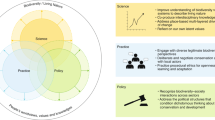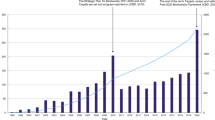Abstract
The lack of urgent action to reverse biodiversity loss is partly due to the complex nature of biodiversity as a feature of our planet. Subsequently, policymakers receive an often-confusing variety of narratives on why biodiversity matters, which makes it difficult to link biodiversity loss and risks to the attainment of sustainable development. Making this link clearer calls for a multidimensional perspective on biodiversity to reassess what we value, facilitate mainstreaming and support national decision-making. We propose a co-produced Multidimensional Biodiversity Index to connect biodiversity science to the political agenda that accounts for the diversity of values underpinning nature–human relationships.
This is a preview of subscription content, access via your institution
Access options
Access Nature and 54 other Nature Portfolio journals
Get Nature+, our best-value online-access subscription
$29.99 / 30 days
cancel any time
Subscribe to this journal
Receive 12 digital issues and online access to articles
$119.00 per year
only $9.92 per issue
Buy this article
- Purchase on Springer Link
- Instant access to full article PDF
Prices may be subject to local taxes which are calculated during checkout



Similar content being viewed by others
References
Summary for Policymakers of the Global Assessment Report on Biodiversity and Ecosystem Services of the Intergovernmental Science-Policy Platform on Biodiversity and Ecosystem Services (IPBES Secretariat, 2019).
Measuring Progress: Towards Achieving the Environmental Dimension of the SDGs (UNEP, 2019).
Blicharska, M. et al. Biodiversity’s contributions to sustainable development. Nat. Sustain 2, 1083–1093 (2019).
The Global Risks Report 2020 (World Economic Forum, 2020).
Díaz, S. et al. Pervasive human-driven decline of life on Earth points to the need for transformative change. Science 366, eaax3100 (2019).
Dasgupta, P. The Economics of Biodiversity: The Dasgupta Review (HM Treasury, 2021).
Pascual, U. et al. Biodiversity and the challenge of pluralism. Nat. Sustain. 4, 567–572 (2021).
The Assessment Report on Land Degradation and Restoration (IPBES Secretariat, 2018).
UNEP Frontiers 2016 Report: Emerging Issues of Environment Concern (UNEP, 2016).
Workshop Report on Biodiversity and Pandemics of the Intergovernmental Platform on Biodiversity and Ecosystem Services (IPBES Secretariat, 2020).
Tittensor, D. P. et al. A mid-term analysis of progress toward international biodiversity targets. Science 346, 241–244 (2014).
Global Biodiversity Outlook Vol. 25 (Secretariat of the CBD, 2014).
Newbold, T. et al. Has land use pushed terrestrial biodiversity beyond the planetary boundary? A global assessment. Science 353, 288–291 (2016).
Butchart, S. H. M. et al. Improvements to the Red List Index. PLoS ONE 2, e140 (2007).
McRae, L., Deinet, S. & Freeman, R. The diversity-weighted living planet index: controlling for taxonomic bias in a global biodiversity indicator. PLoS ONE 12, e0169156 (2017).
Pascual, U. et al. Valuing nature’s contributions to people: the IPBES approach. Curr. Opin. Environ. Sustain. 26–27, 7–16 (2017).
Human Development Report 2020: The Next Frontier—Human Development and the Anthropocene (UNDP, 2020).
Global Multidimensional Poverty Index 2020—Charting Pathways out of Multidimensional Poverty (UNDP & OPHI, 2020).
Becker, F. G. et al. Global Slavery Index 2018 (Walk Free Foundation, 2018).
2020 ITUC Global Rights Index: The World’s Worst Countries for Workers (ITUC, 2020).
Corruption Perceptions Index 2020 (Transparency International, 2020).
Soto-Navarro, C. A. et al. Building a Multidimensional Biodiversity Index—A Scorecard for Biodiversity Health (UNEP-WCMC, 2020); https://www.unep-wcmc.org/resources-and-data/building-a-multidimensional-biodiversity-index
Stiglitz, J. E., Fitoussi, J.-P. & Durand, M. Beyond GDP: Measuring What Counts for Economic and Social Performance (OECD, 2018).
Van den Bergh, J. C. J. M. The GDP paradox. J. Econ. Psychol. 30, 117–135 (2009).
UNDP Strategic Plan, 2018-2021 (UNDP, 2017).
Dasgupta, P. Human Well-Being and the Natural Environment (Oxford Univ. Press, 2001).
Costanza, R. et al. Time to leave GDP behind. Nature 505, 283–285 (2014).
Raworth, K. Doughnut Economics: Seven Ways to Think Like a 21st-Century Economist (Random House, 2017).
Mazzucato, M. The Value of Everything: Making and Taking in the Global Economy (Penguin, 2019).
Perrings, C. et al. Biodiversity in agricultural landscapes: saving natural capital without losing interest. Conserv. Biol. 20, 263–264 (2006).
Primmer, E. & Paavola, J. Insurance value of ecosystems: an introduction. Ecol. Econ. 184, 107001 (2021).
Jørgensen, S. L., Termansen, M. & Pascual, U. Natural insurance as condition for market insurance: climate change adaptation in agriculture. Ecol. Econ. 169, 106489 (2020).
UNEP/CBD/COP/DEC/X/2 Strategic Plan for Biodiversity (2011-2020) and the Aichi Biodiversity Targets (CBD, 2010).
Hansen, M. H., Li, H. & Svarverud, R. Ecological civilization: interpreting the Chinese past, projecting the global future. Glob. Environ. Change 53, 195–203 (2018).
Gruetzmacher, K. et al. The Berlin principles on one health—bridging global health and conservation. Sci. Total Environ. 764, 142919 (2021).
IPCC: Summary for Policymakers. In Special Report on Global Warming of 1.5 °C (eds Masson-Delmotte, V. et al.) (WMO, 2018).
2019—Global Report on Food Crises: Joint Analysis for Better Decisions (Food Security Information Network, 2019).
CBD/WG2020/2/4 29 Report of the Open-Ended Working Group on the Post-2020 Global Biodiversity Framework on its Second Meeting (CBD, 2020).
Cardinale, B. J. et al. Biodiversity loss and its impact on humanity. Nature 486, 59–67 (2012).
Chan, K. M. A. et al. Opinion: why protect nature? Rethinking values and the environment. Proc. Natl Acad. Sci. USA 113, 1462–1465 (2016).
Chan, K. M. A., Gould, R. K. & Pascual, U. Editorial overview: relational values: what are they, and what’s the fuss about? Curr. Opin. Environ. Sustain. 35, A1–A7 (2018).
Díaz, S. et al. Assessing nature’s contributions to people. Science 359, 270–272 (2018).
Convention on Biological Diversity (United Nations, 1992).
Mace, G. M. et al. Aiming higher to bend the curve of biodiversity loss. Nat. Sustain 1, 448–451 (2018).
Pereira, H. M. et al. Essential biodiversity variables. Science 339, 277–278 (2013).
Chaplin-Kramer, R. et al. Global modeling of nature’s contributions to people. Science 366, 255–258 (2019).
Greco, S., Ishizaka, A., Tasiou, M. & Torrisi, G. On the methodological framework of composite indices: a review of the issues of weighting, aggregation, and robustness. Soc. Indic. Res. 141, 61–94 (2019).
Handbook on Constructing Composite Indicators—Methodology and User Guide (OECD, 2008).
Kumar, P. (ed.) The Economics of Ecosystems and Biodiversity: Ecological and Economic Foundations (Earthscan, 2010).
Folke, C., Biggs, R., Norström, A. V., Reyers, B. & Rockström, J. Social-ecological resilience and biosphere-based sustainability science. Ecol. Soc. 21, 41 (2016).
The Global Goals for Sustainable Development (Global Goals); http://www.globalgoals.org/resources
Zenghelis, D. et al. Valuing Wealth, Building Prosperity: Wealth Economy Project First Year Report to LetterOne (Bennett Institute for Public Policy, 2020).
Halpern, B. S. et al. An index to assess the health and benefits of the global ocean. Nature 488, 615–620 (2012).
Wendling, Z. A. et al. 2020 Environmental Performance Index (Yale Center for Environmental Law & Policy, 2020).
Borucke, M. et al. Accounting for demand and supply of the biosphere’s regenerative capacity: the national footprint accounts’ underlying methodology and framework. Ecol. Indic. 24, 518–533 (2013).
Sachs, J. et al. The Sustainable Development Goals and COVID-19: Sustainable Development Report 2020 (Cambridge Univ. Press, 2020).
Usubiago-Liano, A. & Ekins, P. Developing a Novel Index of Strong Environmental Sustainability: Preliminary Results (Institute for Sustainable Resources, University College London, 2019).
Acosta, L. A. et al. Green Growth Index 2020—Measuring Performance in Achieving SDG Targets Technical Report No. 16 (GGGI, 2020).
Agrobiodiversity Index Report 2019: Risk and Resilience (Biodiversity International, 2019).
Angulo, R., Díaz, Y. & Pardo, R. The Colombian multidimensional poverty index: measuring poverty in a public policy context. Soc. Indic. Res. 127, 1–38 (2016).
Watts, K. et al. Ecological time lags and the journey towards conservation success. Nat. Ecol. Evol. 4, 304–311 (2020).
Acknowledgements
We would like to dedicate this work to the fond memory of our colleague Georgina Mace, who provided essential intellectual input for this work and who continues to be a great inspiration for all of us on fighting the biodiversity loss crisis. We thank the Luc Hoffmann Institute for supporting this project from its inception and the MAVA Foundation for its financial support. This work has benefited from discussions at a variety of international meetings linked to the CBD post-2020 process, and with conservation scientists, policymakers and practitioner colleagues around the world. We are grateful to J. Vause and we thank all organizations who nurtured this dialogue by participating in workshops organized in Cambridge, Zurich and Davos in 2019 and 2020 funded by the Luc Hoffmann Institute, the National Geographic Society, the Nature Map consortium (funded by the Norwegian government) and the UN Environment Programme World Conservation Monitoring Centre.
Author information
Authors and Affiliations
Contributions
C.A.S.-N. developed the original idea with conceptual inputs from all authors, but especially from M.H. and S.L.L.H. C.A.S.-N. and N.D.B. led the writing of the manuscript with input on drafts from all authors. C.A.S.-N. generated all figures and all authors approved the final version of the manuscript.
Corresponding author
Ethics declarations
Competing interests
The authors declare no competing interests.
Additional information
Peer review information Nature Sustainability thanks Malgorzata Blicharska, Zuzana Harmáčková and the other, anonymous, reviewer(s) for their contribution to the peer review of this work.
Publisher’s note Springer Nature remains neutral with regard to jurisdictional claims in published maps and institutional affiliations.
Rights and permissions
About this article
Cite this article
Soto-Navarro, C.A., Harfoot, M., Hill, S.L.L. et al. Towards a multidimensional biodiversity index for national application. Nat Sustain 4, 933–942 (2021). https://doi.org/10.1038/s41893-021-00753-z
Received:
Accepted:
Published:
Issue Date:
DOI: https://doi.org/10.1038/s41893-021-00753-z



